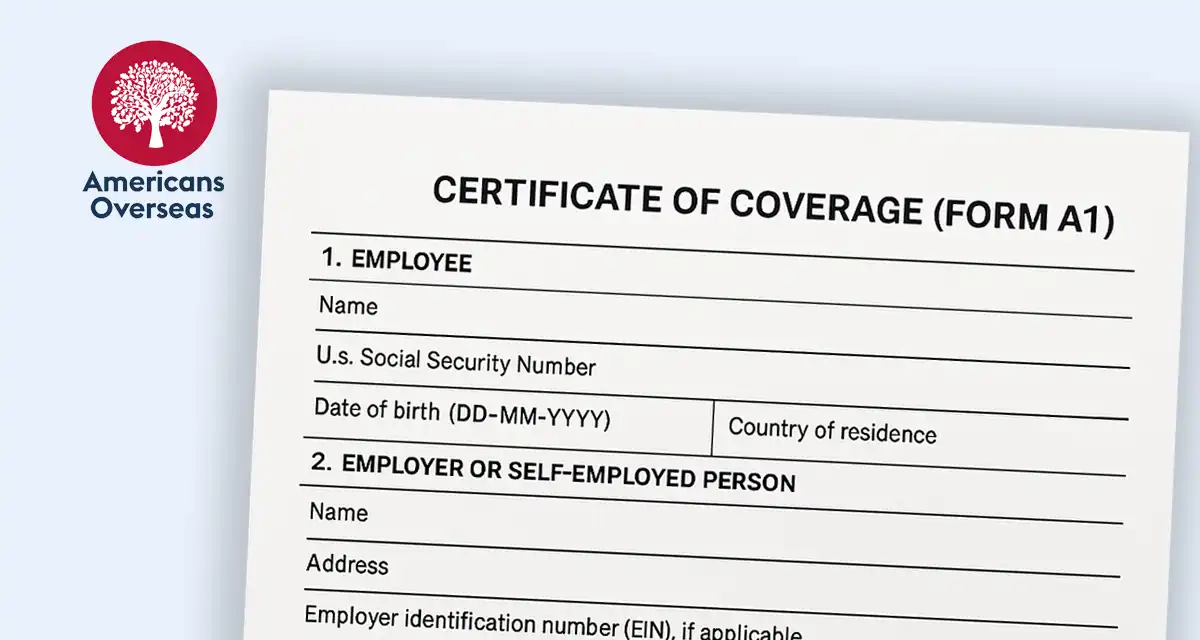Certificate of Coverage (Form A1)

Summary
Form A1 proves you’ve paid social security contributions in your resident country, preventing double taxation for self-employed individuals filing US tax returns. Required in Europe, including the Netherlands, it must be submitted to the IRS to avoid US self-employment taxes. Contact Americans Overseas for guidance.
Are you self-employed and living in the EU? A Certificate of Coverage may help you avoid double taxation on your income. Here’s what you need to know:
What is a Certificate of Coverage and why do you need one?
A Certificate of Coverage, also known as a Form A1 within the EU, is used to prove that you’re already paying into a social security system abroad — preventing double taxation for Americans living overseas. Whether you’re a self-employed U.S. citizen, a remote worker, or on temporary assignment, this certificate can save you from paying 15.3% U.S. self-employment tax again on the same income.
The Form A1 is commonly required when living in an EU/EEA country. Outside the EU, the SSA Certificate of Coverage (from the U.S. Social Security Administration) serves the same function under Totalization Agreements.
Not having one can lead to:
- Being charged U.S. self-employment tax unnecessarily
- Delays in IRS processing
- Issues with FATCA compliance
- Border control questions
A Certificate of Coverage (or Form A1) is a critical document for self-employed individuals filing their US tax return while residing abroad. It demonstrates that you have paid your social security contributions in the country where you live and pay taxes. This prevents double taxation under social security tax treaties.
By including Form A1 with your US tax return, you show the IRS that you are complying with local social security laws, ensuring you avoid paying US self-employment tax on the same income.
Do I Need Form A1 if I Live in Another European Country?
Yes. If you live and work in a European country other than the Netherlands, you still need to show proof of your social security contributions. You can request Form A1 by contacting the relevant authority in your country.
For more information on how to obtain this form, use this EU contact list for social security forms.
How to Obtain Form A1 in the Netherlands
If you reside and pay taxes in the Netherlands, you can request Form A1 by completing the necessary application form provided by the SVB (Sociale Verzekeringsbank).
The form is primarily designed for employees working abroad, so not all sections will apply to US persons who are self-employed. You should:
- Write “N/A, see attachment” for irrelevant questions.
- Include a written explanation clarifying your situation as a US person and why the document is required for your US tax return.
- Attach supporting documents, such as VAT filings or proof of business activity.
Once completed, send the form by post to the SVB address provided at the bottom of the application form. Keep copies of all documents for your records.
Why is Form A1 Necessary?
Failing to request a Certificate of Coverage can lead to double taxation. Without this document, the IRS may treat your social security contributions as unpaid, potentially imposing self-employment tax on your US tax return.
The US has tax treaties with many European countries to prevent double taxation, and Form A1 acts as proof that you have already paid your social security contributions locally.
Is it really necessary to apply for Form A1 ?
If you would not request the Certificate of Coverage, there is a good chance that your US tax return will show that you have to pay tax in the US, because Social security is also taxed in the US for self-employment. However, because the US and most European countries have a tax treaty to prevent double taxation, you can use this Certificate of Coverage to demonstrate that you have already paid your social security contributions, in the country where you live and pay your taxes, for the period that you were self-employed
Relinquishing Social Security Liability
If you no longer work as a self-employed individual or have ceased business activities, ensure you update your Certificate of Coverage status with the local authority to avoid unnecessary contributions.
Understanding Totalization Agreements
The United States has Totalization Agreements with more than 30 countries, including most of Europe, to coordinate social security systems. These treaties:
- Prevent double taxation for workers abroad
- Determine which country has taxing rights over social security
- Allow individuals to combine work credits for retirement benefits
See the full country list from the SSA
If you live in:
- Germany → Apply via the A1-Bescheinigung
- France → Use the CLEISS system
- Belgium → Use RSZ/NSSO
- UK → Use HMRC’s CA9107 form
These processes vary by country, but all help prevent paying social security tax twice.
Frequently Asked Questions
What’s the difference between Form A1 and the Certificate of Coverage from the SSA?
Form A1 is the EU version, typically issued by local authorities. The SSA Certificate is for other countries with Totalization Agreements (e.g., US–Canada, US–Japan).
Can I apply online?
Yes, some countries (like Germany or the UK) offer online A1 form applications.
How long is the certificate valid?
Typically 12 months, but validity can vary by country.
Can I get an extension?
Yes, an extension may be granted by reapplying before the expiration date.
Is it needed for short trips abroad?
Yes — especially if you’re working even temporarily. Ask: “Do I need an A1 certificate for a business trip?” If you’re earning income, the answer is often yes.
What happens if my application is denied?
Consult with Americans Overseas. You may still avoid U.S. taxation by filing under a treaty-based return position(Form 8833).
What if I’m both employed and self-employed?
You may need multiple forms or coordination between countries.
What if I don’t submit Form A1?
Without Form A1, the IRS may impose self-employment tax, increasing your tax liability.
Can I request Form A1 for past tax years?
Yes, you can often apply retroactively if you can provide proof of past contributions.
Is Form A1 mandatory for employees?
No, it is typically required for self-employed individuals. Employees working abroad are usually covered under their employer’s social security arrangements.
Certificate of Coverage for Different Situations
- Self-employed Americans living in the EU: A1 form is required to avoid 15.3% U.S. tax
- Employees on temporary assignment: Usually covered by employer but may still need proof
- Digital nomads: Must demonstrate social security contributions in the country of residence
- Remote workers: May need to request an A1 certificate as self-employed
- Business travelers: Short trips may still require coverage proof
- Dual-status workers: Check for partial A1 eligibility
Need Help with Your Certificate of Coverage (Form A1)?
Navigating US tax rules as a self-employed expat can be complex. Americans Overseas offers free guidance and connects you to US tax experts to ensure compliance with IRS requirements.
Contact us today to learn more about filing Form A1 or resolving your US tax obligations.
Required Documents Checklist
For self-employed individuals:
- VAT or Chamber of Commerce registration
- Proof of business activity (invoices, tax filings)
- U.S. passport
- Cover letter explaining U.S. tax status
For employees:
- Employment contract
- Employer statement
- Payroll documentation
Translations may be required in some countries.
Common Certificate of Coverage Terms
- Form A1: The EU form showing you’re insured under a European country’s social security.
- Certificate of Coverage SSA: The U.S. version issued by the Social Security Administration for use outside the EU.
- Totalization Agreement: A treaty that coordinates social security systems between countries.
- Form 8833: The IRS form used to claim treaty benefits on your U.S. tax return.
- Self-employment tax: A 15.3% tax levied by the IRS on net self-employment income.




